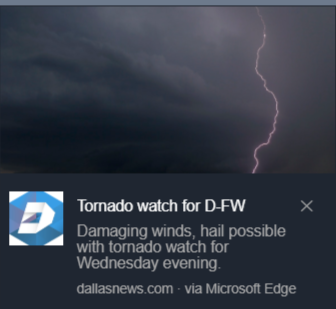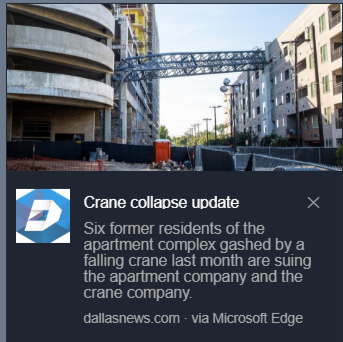How The Dallas Morning News uses push notifications to grow audience
Mark Francescutti and Nicole Stockdale, The Dallas Morning News,This is a series on Better News to a) showcase innovative/experimental ideas that emerge from the Knight-Lenfest Newsroom Initiative and b) to share replicable tactics that benefit the news industry as a whole. This “win” comes from Mark Francescutti, director of marketing engagement and operations, and Nicole Stockdale, director of digital strategy, both at The Dallas Morning News.
Question: What problem were you trying to solve, and why was solving the problem strategically important for your organization?
Answer: Digital subscriptions are the No. 1 goal for The Dallas Morning News. Two of the strongest metrics to drive digital subs are returning visitors and session depth. We wanted a better way to increase the number of return visitors to our stories and to target readers with the content they want — without requiring them to come to our homepage at dallasnews.com or find our content in the middle of their packed, algorithm-driven social media feed.
Q: How is this approach related to Table Stakes (e.g. one of the 7 Table Stakes and/or an outgrowth of the Knight-Lenfest initiative, etc.)?
A: This approach is directly related to Table Stake No. 2: Publish on platforms used by your targeted audiences.
Q: How did you go about solving the problem?
A: We had not engaged in browser-based push notifications, so we wanted to try it. We are partnering with an organization called Pushly, which provides an easy web-based user interface to send push notifications in a matter of seconds. We chose Pushly because it had an easy, out-of-the-box CMS and pretty painless integration. (Note: Most push notification services have several plans, usually starting in the $1,000-$10,000 per month range. Most of the cost is based on how many subscribers you have.)
When a visitor first comes to our site, they see a prompt asking them if they want to allow push notifications. This prompt appears on all pages and is not repeated if the user selects no.
Browser-based push notifications are not available on iPhones or iPads (mobile iOS), so our pushes are limited to Android and Windows devices.
Pushly also allows us to heavily segment the audience in incredible ways. For example, we can segment the audience based on their ZIP code, whether they visited a previous article about a topic, which section they signed up for alerts on, and more.
More broadly, we want to publish on the platforms used by our targeted audiences. Our advice is: Go to your audiences rather than expecting them to come to you. Take responsibility for publishing and promoting on the platforms used by each of your chosen target audiences. Do so in ways that serve their needs and interests in using each platform and take advantage of the particular features and dynamics of the platforms themselves.
In other words: Be platform-optimal, not platform-agnostic.
We now have about 15 people trained to use the platform. They log onto a site and publish between five to 15 notifications per day.
Q: What worked?
A: Pushly’s push notifications now lead to 4% of our overall views and 11% of our returning views. The push notifications have spurred hundreds of digital subscriptions this year and have helped us more than double our return visitors year-over-year. The platform pays for itself with an increase in ad revenue, which comes from the increased traffic.
The push strategy has performed far above our expectations. We now have more than 800,000 users subscribed to pushes. Our pushes far outperform our social media accounts, which is reflected in data from Oct. 14 to Nov. 13, 2019.
DallasNews Twitter: 77 clicks per post
DallasNews Facebook: 1,162 clicks per post (Virality is a huge factor: Half of Facebook link clicks came from only 10 of the 501 posts.)
Pushly: 2,270 clicks per push
In July, we finally got to the 5% click-rate benchmark by sending fewer broad-based messages and many more smart-targeted ones. (The industry standard is a 5% click-rate on a push notification.)
We smartly used segments to follow people interested in a story: If you clicked on story X, we pushed to you updates Y and Z and got stellar results — 20-25% click-rates.
For example, a reader clicked on a push involving a court case. When we have an update in the case, we send the push to only those who clicked on the original story. It’s a great way to keep readers interested in a topic informed about new details.
One real-life example: Dallas suffered from massive thunderstorms in June. Many homes and businesses suffered damage, including a crane collapse into a building. The folks that clicked on the original story were targeted with smaller updates on the storm damage. Those pushes averaged a 25% click-rate.
We made these pushes successful on Android phones. Since browser-based pushes don’t work on iOS, we weren’t sure how successful we would be on Androids, but our metrics show two-thirds of the push subscribers came from there. (The other third came from desktop.)
 |
 |
 |
Q: What didn’t work?
A: We got lots of complaints from people who wanted to unsubscribe but didn’t know how. We had to educate customer service on how to respond. We still need ways to segment more smartly.
Our team of journalists who focus on audience engagement had to take the extra step of making push notifications more engaging, tap-worthy — and less vague. And we often wrote headlines too long. The body of the push text probably needs to be shorter to fit on many devices. You can always see these on the preview tab of the notification screen.
Q: What happened that you didn’t expect?
A: We really started working with Pushly just as a test. When we saw the results, we were shocked — in a good way. We added many more users than we expected, and we then started strategizing about how to use the tool for more than just daily breaking-news alerts — and how to spread the use of this tool beyond the newsroom’s Audience team.
Q: What would you do differently now? What did you learn?
A: Honestly, we wish we’d have started this much sooner! Besides that, we had to experiment with ways not to bombard users with too many notifications. One example: Say your work computer is shut down for the weekend, but when you come back on Monday morning, you see five older alerts waiting for you, which makes you want to unsubscribe. We solved this problem by changing the settings to allow only the most recent push to show at any time.
Q: What advice would you give to others who try to do this?
A: This tool has a lot of promise for news organizations that are trying to drive habitual readership. By definition, you know every one of the click-throughs is from a return visitor.
Also, get ready to segment, segment, segment — and have a plan for how to divvy up the workload. Segment experimentation could get overwhelming for one person, but if you spread it out to editors who are closest to the content, they can get creative with which segments to target. We also tag push notifications with the same tags we use in our internal content-management system. We can use that tagging to segment users later in the process.
But don’t forget that the more segments you experiment with, the more of a chance there is for overlap, meaning you might be sending any one user more than you originally intended. Figure out a way to communicate what’s being sent to whom.
Q: Anything else you want to share about this initiative?
A: We can pay for this initiative strictly from the increased ad revenue. Make sure to make that point if you’re trying to get it approved at your shop. Long-term, we have a few goals: One, to find a way to target iOS mobile users. Two, to make segmenting so smart, we can push every story to a target audience that wants it.